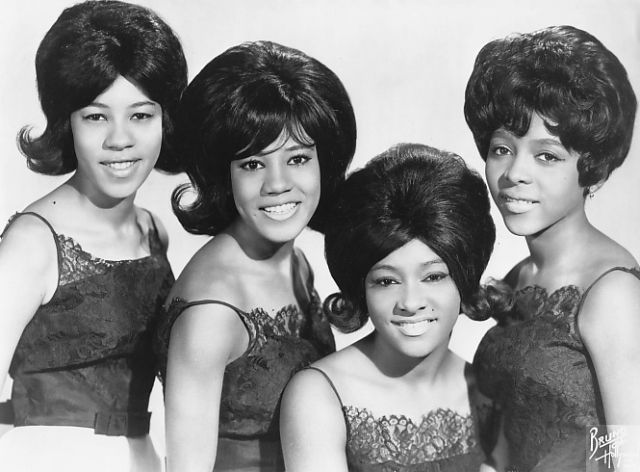
Few early-1960s singles capture the head-spinning rush of a first romance as vividly as The Crystals’ “Then He Kissed Me.” Released in 1963 during the golden girl-group era and masterfully produced by Phil Spector, this track is not just a song—it’s a touchstone for pop arrangement, vocal blend, and narrative songwriting. The record blooms through the radio speaker with a mono, dense, and cinematic presence, yet beneath its deceptively storybook simplicity lies a sophisticated architecture merging orchestral color, rock rhythm, and street-corner R&B, all fused into Spector’s legendary Wall of Sound.
Initially presented as a stand-alone 45 rpm single on Philles Records, the song soon found its permanent home on the LP Golden Hits of the Crystals (1963). This compilation gathered the group’s biggest hits—“Da Doo Ron Ron,” “He’s a Rebel,” “Uptown,” and “He’s Sure the Boy I Love”—offering a broader narrative frame. Remarkably, the LP contextualizes “Then He Kissed Me” as part of an evolving journey, bridging streetwise confidence and urbane romanticism.
The track’s soundworld is a masterclass in arrangement. The steady drum pulse, buoyant bass line, and layered pianos craft a rhythm with march-like confidence, evoking a couple’s poised dance on the floor. The presence of guitars—acoustic paired with electrics—and glockenspiel-like percussion add a bell-like halo, presenting the track’s signature sparkle. The castanets and tambourine chatter intricately, providing rhythmic counter-melodies that flirt with the vocals, while the lush strings expand the stereo field and add lush harmonic air.
Notably, the famous Gold Star Studios echo does more than provide reverb; it perfectly blends the ensemble so no single instrument dominates. The density created by doubling and tripling lines—piano doubling guitar, bass doubling low piano, mallets doubling arpeggios—gives the song a monumental feeling without heaviness.
At its core, The Crystals’ lead vocal is clear, youthful, and poised, unfolding a linear narrative through chance meeting, dance, kiss, parental blessing, and a promise of forever. The backing vocals act as a communal presence—gentle cushions during verses, celebratory choirs in choruses—turning a single girl’s story into a universal rite of passage. This cinematic storytelling with choral precision remains one of the song’s most profound achievements.
The songwriters Phil Spector, Ellie Greenwich, and Jeff Barry crafted an elegant harmonic spine focused on momentum, avoiding surprise while creating singable yet elevated melodic hooks. With clarity in lyrics and unforgettable pacing, the song compresses a romance into decisive milestones. Its bridge offers just the right contrast before soaring back to a warmer chorus, making it feel like a perfectly balanced short story.
Technically, the song is a marvel of mono production, designed to sound massive through small car speakers or transistor radios. The smart mix uses compression, echo chambers, and EQ to emphasize the lead vocal without stealing space from the orchestra. Instruments bleed into one another, making the Wall of Sound feel like a single living organism.
Interestingly, the storytelling mode of the song resonates across genres. Though the Crystals were an urban girl group, the structure mimics country tradition, with clear, milestone-driven plotlines and moral arcs. Added to this, the orchestration incorporates classical techniques—dynamic string swells and chamber music-style counter-melodies—that enrich the song’s texture.
Even decades after release, “Then He Kissed Me” remains a cultural touchstone, thriving at weddings, film soundtracks, and streaming services. It’s favored for its innocence, tempo, and unmistakable narrative clarity. The mono mix translates beautifully on modern earbuds and smart speakers, allowing listeners to feel the story as both background and focused listening.
Legendary producer Phil Spector’s philosophy treated adolescent emotion with grandeur, turning a first kiss’s excitement into musical form: drums as a heartbeat, castanets as fluttering nerves, strings as luminescent glow. The result is a blueprint for emotional clarity that remains vital to producers, songwriters, and fans of carefully crafted pop music.
Listeners should note on their next spin the intro sparkle with chiming mallets, the verse pacing building momentum, and the chorus lift where strings and vocals bloom. Percussion like castanets and tambourine engage in call-and-response with vocals, while the final refrain heightens without a key change, demonstrating arrangement as storytelling.
Fans drawn to this masterpiece might explore similar works such as The Ronettes’ “Be My Baby”, The Crystals’ “Da Doo Ron Ron”, The Shangri-Las’ “Leader of the Pack”, The Shirelles’ “Will You Love Me Tomorrow”, The Beach Boys’ “Then I Kissed Her”, and Lesley Gore’s “You Don’t Own Me.” These tracks echo the timeless art and influence stamped by “Then He Kissed Me.”
In a powerful summation, the track isn’t a mere nostalgic artifact but a foundational record in pop craftsmanship, uniting storytelling clarity with classical dynamics and irresistible singability. The layered instruments, empathetic vocals, and production techniques create an intimate yet monumental soundscape that still makes hearts race, preserving a universal spark across generations. As one insider noted, the song is a precious reminder of how every element in pop music can serve the feeling—making magic that lasts a lifetime.
